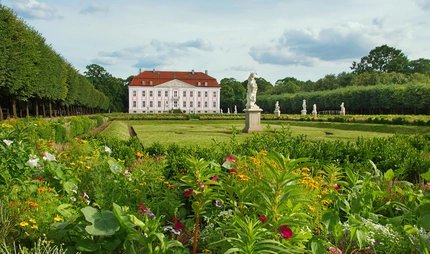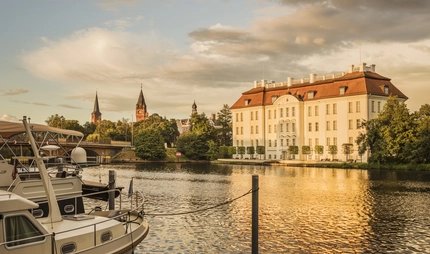
Schloss Schönhausen
A manor house, apartment and conference venue
In Pankow you will find the Schönhausen House and Estate: once the summer residence of the Prussian kings and then the seat of the East German head of state, it now houses exhibitions.
In the course of history, a Prussian summer residence developed into a guest house for Gandhi, Gaddafi and co. Schönhausen Palace in Berlin-Pankow became a centre of politics and history over the course of time. You will also be captivated by annually changing exhibitions.
The palace building is surrounded by a vast green park landscape through which the Panke river flows. Here you can go for a wonderful walk, but for picnics and sporting activities, please use the surrounding green spaces suitable for this purpose.

A generous gift
The story begins when a manor house was built on the site in 1664. In the period up to 1740 many conversions took place, secret negotiations were held there and court officials lodged there. This changed when King Friedrich II – known affectionately as “Alter Fritz” – gifted it to his wife Elisabeth Christine. She spent the hot summer months there for 50 years and extended it to a Rococo palace.

Its opulent rooms with stucco ceilings and brightly coloured floral carpets can still be admired today. At Schönhausen, Elisabeth Christine was really in exile, because her husband, who did not want her around, never paid her a visit at her beautiful summer residence.
Schönhausen House under the Nazis and in the GDR
During the Nazi era, the palace was used for exhibitions and as a place to store artworks. 780 paintings and sculptures and around 3500 works on paper by proscribed artists were stored there, some of which were shown in the “Degenerate Art” exhibition.
After the partition of Germany, the first – and only – President of the GDR, Wilhelm Pieck, used the palace as his official seat. The presidential garden is a reminder of this time. In the following years the East German State Council moved in. From 1965 to 1990 it was repurposed as a guest house for official visitors of the GDR. Those invited included Indira Gandhi, Fidel Castro, Muammar al-Gaddafi, Kim Il-sung, Leonid Ilyich Brezhnev and Mikhail Gorbachev. The building is now open to the public and features a guest room with its 1960s furnishings.
The rectangular “round table” where Germany was reunified
The “Central Round Table” set up at the end of 1989 to discuss the reform of the GDR made use of the convivial atmosphere of the casino building at the Schönhausen House. From the fourth round of negotiations in 1989 to 12 March 1990, the reunification of Germany was prepared and a constitution for a joint state drafted, but this never saw the light of day. Technically, the term “Round Table” was a misnomer: the actual table where they met, worked and discussed was rectangular. It was simply named after the democratic negotiations that had taken place in Poland, which were held at a table which actually was round.
Experience the palace with all your senses
Braille panels and audio guides allow barrier-free access for people who are blind or visually impaired to explore the palace. You can touch replica costumes to get a feel of them. There is a video guide to the palace rooms for tourists with hearing impairments. Schloss Schönhausen is an outstanding example of barrier-free sightseeing.

Around Rathaus Pankow
You can’t miss Pankow’s red clinker brick town hall. Many shops have sprung up around Rathausplatz in recent years. Take a walk through the area and admire the architectural styles of different eras.
Find out more about the city’s neighbourhoods with our Going Local Berlin app.
Opening Hours
Open all year round



